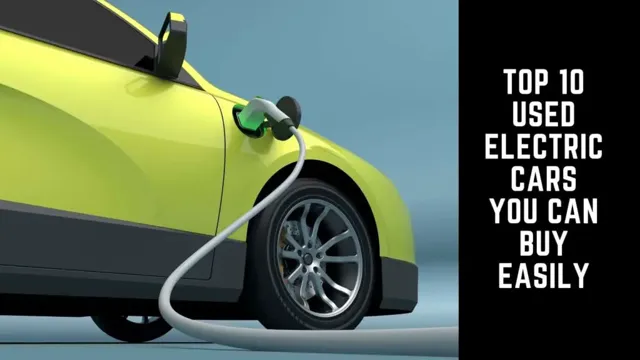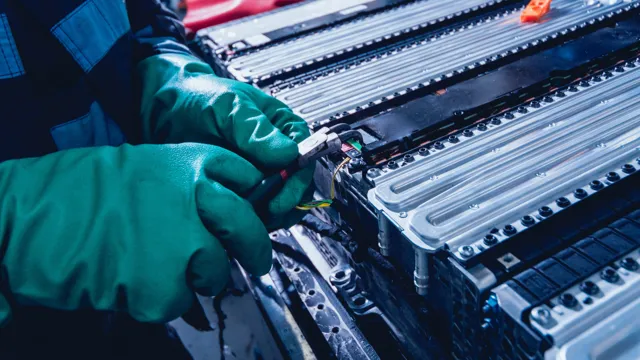The Revolutionary Technology Powering the Electric Car Movement: Exploring the Advancements in EV Tech
Electric cars are no longer a thing of the future, but rather a reality of the present. More and more people are turning to electric vehicles as their primary transportation mode, and it’s not hard to see why. Not only is it an eco-friendly option, but electric cars are known for their smooth and quiet rides, and their ability to save on fuel costs.
But what many people don’t realize is the amount of technology that goes into making electric cars possible. From the batteries to the charging systems, electric vehicles have revolutionized the transportation industry. In this blog, we will explore the different types of technology used in electric cars and how they work together to create a sustainable and efficient driving experience.
Electric Motors
When it comes to electric cars, one of the key technologies that make them run is the electric motor. These motors are designed to convert electrical energy into mechanical energy, which in turn powers the wheels of the car. The most common types of motors used in electric cars are permanent magnet motors and induction motors.
Permanent magnet motors use fixed magnets to generate the electromagnetic field needed to move the car, while induction motors create their own electromagnetic fields using current passed through coils of wire. Both types of motors have their own advantages and disadvantages. Induction motors are more efficient at higher speeds, while permanent magnet motors are better suited for lower speed applications.
Regardless of which type of motor is used, manufacturers are always striving to improve efficiency, reduce weight, and increase power output to make electric cars more practical and affordable for everyday use. Ultimately, the technology used in electric cars is constantly evolving, and it will be interesting to see what advancements are made in the coming years.
Permanent Magnet Motor vs Induction Motor
Electric Motors Electric motors can be classified into two main categories: permanent magnet motor and induction motor. The main difference between these two types of motors lies in their design and functionality. As the name suggests, a permanent magnet motor uses a permanent magnet to create a magnetic field that interacts with the currents in the rotor to generate torque.
On the other hand, an induction motor uses electromagnetic induction to create a magnetic field that drives the rotor. Permanent magnet motors are known for their high efficiency and power density, making them ideal for a wide range of applications. They are also more compact and less complex than induction motors.
However, permanent magnet motors can be more expensive than induction motors due to the cost of the rare earth magnets used to create the magnetic field. Induction motors, on the other hand, are more cost-effective and widely used in industrial and commercial applications. While they may not be as efficient as permanent magnet motors, they make up for it in their robustness and durability.
Induction motors are also able to handle a wide range of load conditions, making them ideal for applications that require variable speed or variable torque. In conclusion, both permanent magnet motors and induction motors have their pros and cons, and the choice of motor depends on the specific application and requirements. Whether you choose a permanent magnet motor or an induction motor, it’s important to understand their strengths and limitations to make an informed decision.

Regenerative Braking System
Electric motors are a crucial component of modern vehicles, and they can significantly impact the vehicle’s overall efficiency and sustainability. One of the primary benefits of electric motors is their ability to harness energy through regenerative braking systems. This feature allows the electric motor to capture the energy that is typically lost during braking and use it to recharge the vehicle’s battery.
By doing so, the vehicle can reduce its overall energy consumption and extend its range. Regenerative braking systems work by converting the vehicle’s kinetic energy into electrical energy that is then stored in the battery. This innovative technology has revolutionized the way we think about vehicle propulsion and has paved the way for more sustainable and efficient transportation.
It’s important to note that not all electric vehicles have regenerative braking systems, so it’s essential to do your research before purchasing an electric vehicle.
Battery Systems
When it comes to the technology used in electric cars, battery systems are a crucial component. The battery system in an electric vehicle is responsible for storing and delivering electricity to power the electric motor. There are different battery chemistries used in electric cars, such as lithium-ion, nickel-cobalt-aluminum (NCA), nickel-manganese-cobalt (NMC), and solid-state batteries.
Lithium-ion batteries are the most popular and widely used in electric cars due to their high energy density and reasonable cost. However, solid-state batteries are gaining popularity due to their improved safety, longer lifespan, and higher energy density, which means they can store more energy in a smaller space. As electric car technology continues to evolve, battery systems will play an increasingly important role in the industry.
Improvements in battery technology will result in longer range, faster charging times, and lower costs for electric vehicles, making them more accessible to the masses.
Lithium-Ion vs Nickel-Metal Hydride Batteries
When it comes to battery systems, two common options are lithium-ion batteries and nickel-metal hydride batteries. Lithium-ion batteries are often found in modern electronics and electric vehicles due to their high energy density and long lifespan. In contrast, nickel-metal hydride batteries are frequently used in smaller, less complex devices such as flashlights and remote controls.
While lithium-ion batteries have the advantage in terms of energy density and lifespan, they also come with a higher cost. Nickel-metal hydride batteries may not last as long or hold as much power, but they are cheaper and easier to produce. Both types of batteries have their pros and cons, and ultimately the decision of which one to use depends on the specific application and needs.
In summary, while lithium-ion batteries are the preferred choice of modern technology, nickel-metal hydride batteries still have their place in smaller, simpler devices. When it comes to choosing between the two, it’s important to consider factors such as energy density, lifespan, and cost.
Battery Management System
A battery management system (BMS) is an essential component of battery-powered systems. This system monitors and controls the battery’s state, ensuring optimal performance, and prolonging its life. The purpose of a BMS is to protect the battery from various situations such as overcharging, over-discharging, and overheating, which can be detrimental to its operation.
With the help of a BMS, batteries can perform up to their full potential, providing longer life and consistent efficiency, making them the preferred option for powering various applications, including electric vehicles, renewable energy systems, and portable devices. The use of a BMS not only enhances the performance of the battery, but it also ensures safety, making it the most reliable power source for modern technological advancements. Overall, battery systems rely on a functioning BMS, which plays a crucial role in the battery’s maintenance and longevity.
Charging Infrastructure
Electric cars are becoming increasingly popular as people want to reduce their carbon footprint. But what about charging infrastructure? The technology used in electric cars requires a specific infrastructure to support it. This is where charging stations come into play.
These stations are designed to recharge electric cars quickly and efficiently. The charging infrastructure includes fast chargers, which can provide up to 80% charge in as little as 30 minutes. There are also level 2 chargers, which take a few hours to charge up a car completely.
Charging stations are located in various places, such as homes, workplaces, and public areas like shopping malls and parking lots. As the demand for electric cars continues to grow, so too does the need for a reliable charging infrastructure.
Public Charging Stations vs Home Chargers
Charging Infrastructure When it comes to EVs, one of the most critical elements is their charging infrastructure. EV drivers have two options for charging their cars: public charging stations or home chargers. Public charging stations can be found in various locations, including parking lots, shopping centers, and other similar spaces.
Home chargers, as the name implies, are installed in a driver’s home, usually in their garage. While public charging stations offer convenience, especially during long trips, home chargers have a higher level of accessibility and control. They are cheaper to use, and drivers can charge their vehicles overnight, ensuring they are always ready to go.
Public charging stations, on the other hand, can be more expensive, and drivers may need to wait in line to use them, especially during peak times. Ultimately, the choice between public charging stations and home chargers depends on the individual’s needs and preferences. If you are someone who regularly takes long trips, owning an EV and relying solely on public charging stations may be a bit inconvenient.
In contrast, owning a home charger gives you the ability to recharge your vehicle whenever you want, at a much lower cost.
Fast Charging vs Level 2 Charging
When it comes to electric vehicle charging, there are two main types of charging infrastructure: fast charging and Level 2 charging. Fast charging, also known as DC fast charging, is the quickest way to charge your electric vehicle and can provide up to 80% or more battery capacity in as little as 30 minutes. On the other hand, Level 2 charging uses a 240-volt circuit and can take several hours to fully charge your vehicle.
While fast charging may seem like the obvious choice due to its speed, it is important to note that it is not always the most efficient option. Fast charging typically comes at a higher cost and can put more stress on your vehicle’s battery, potentially reducing its lifespan. Level 2 charging, on the other hand, is a more affordable and less stressful option for your electric vehicle’s battery.
It is important to consider your daily driving habits and charging needs when deciding which type of charging infrastructure to invest in. If you tend to drive longer distances and need to quickly top up your battery, fast charging may be the better option for you. However, if you have a regular daily commute and can charge your vehicle overnight, Level 2 charging may be a more practical and cost-effective solution.
Ultimately, the decision comes down to personal preference and the specific needs of your electric vehicle.
Autonomous Driving Technology
When it comes to electric cars, there is no doubt that the technology used in them is constantly evolving. One of the most exciting advancements in recent years has been the development of autonomous driving technology. This technology uses a combination of sensors, cameras and algorithms to enable a car to drive itself without the need for human intervention.
The potential benefits of autonomous driving technology are vast, from increasing road safety to reducing traffic congestion and emissions. However, there are also many challenges associated with this type of technology, such as legal and ethical considerations. Despite these challenges, it’s clear that autonomous driving technology will play a major role in the future of electric cars and is an area that is rapidly evolving.
As we look to the future, it will be fascinating to see how this technology continues to evolve and how it will impact the way we drive and travel.
Cameras, Radars, and Sensors for Self-Driving Cars
Autonomous driving technology is one of the most talked-about subjects in the automotive industry. It’s undoubtedly the future of transportation, with vehicles capable of self-driving, significantly reducing accidents caused by human error. Cameras, radars, and sensors are the key technologies used in self-driving cars.
Cameras are positioned at the front and rear of the vehicle, providing a 360-degree view of the surrounding environment to detect objects such as other cars, pedestrians, and traffic signs. Radars use radio waves to detect objects and obstacles within a distance of up to 200 meters. Sensors, on the other hand, provide information about the vehicle’s speed, direction, and acceleration.
With all these technologies working together, self-driving cars can operate more safely and efficiently, making our roads a safer place. With ongoing developments in autonomous driving technology, we can expect to see more and more self-driving cars on our roads in the future.
Conclusion
In conclusion, the technology used in electric cars is not just about recharging a battery and creating sustainable transportation. It requires a clever combination of advancements in power management, energy storage, and control systems. From regenerative braking to smart charging, electric vehicles rely on sophisticated electronics to maximize efficiency and minimize emissions.
In other words, the magic of electric cars is not just in the electric motor, but the intricate network of cutting-edge technology that powers it. So, next time you see an electric car zooming down the road, remember that it’s not just a green alternative to gas-guzzlers, it’s a smart and sophisticated machine that’s paving the way towards a cleaner, brighter future.”
FAQs
What kind of technology is used in electric cars?
Electric cars use battery technology to power the motor, which converts electrical energy to mechanical energy.
How does regenerative braking work in electric cars?
Regenerative braking is a technology used in electric cars that converts the kinetic energy of braking to electricity and stores it in the car’s battery.
Can electric cars charge while driving?
There are some electric cars that use wireless charging technology, which can charge the car’s battery while it is in motion.
What is the range of electric cars and how does it vary based on the technology used?
The range of electric cars varies based on the battery technology used. Lithium-ion batteries can provide a range of 100-300 miles, while solid-state batteries, which are still in development, could potentially provide a range of 500 miles or more on a single charge.





